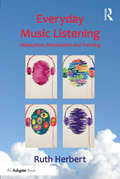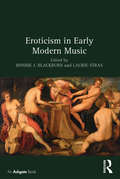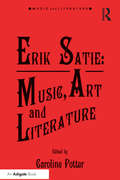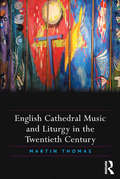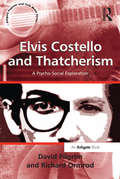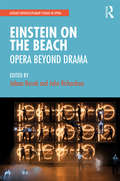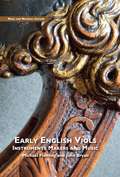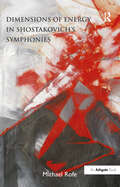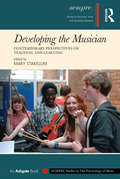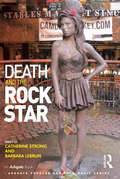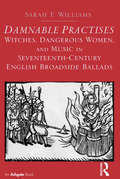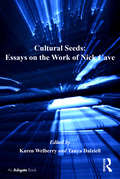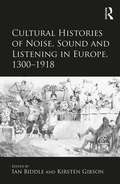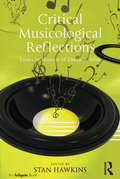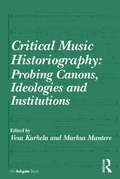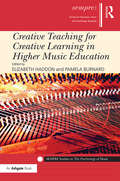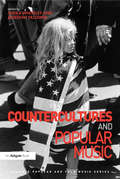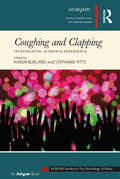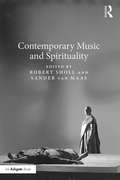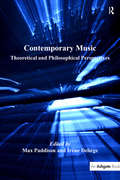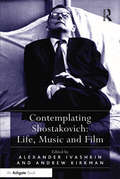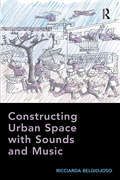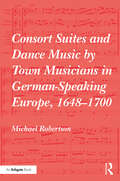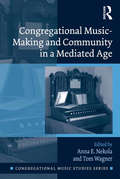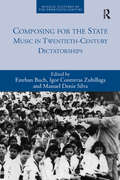- Table View
- List View
Everyday Music Listening: Absorption, Dissociation and Trancing
by Ruth HerbertIn what ways does listening to music shape everyday perception? Is music particularly effective in promoting shifts in consciousness? Is there any difference perceptually between contemplating one's surroundings and experiencing a work of art? Everyday Music Listening is the first book to focus in depth on the detailed nature of music listening episodes as lived mental experiences. Ruth Herbert uses new empirical data to explore the psychological processes involved in everyday music listening scenarios, charting interactions between music, perceiver and environment in a diverse range of real-world contexts. Findings are integrated with insights from a broad range of literature, including consciousness studies and research into altered states of consciousness, as well as ideas from ethology and evolutionary psychology, suggesting that a psychobiological capacity for trancing is linked to the origins of making and receiving of art. The term 'trance' is not generally associated with music listening outside ethnomusicological studies of strong experiences, yet 'hypnotic-like' involvements in daily life have long been recognized by hypnotherapy researchers. The author argues that multiply distributed attention - prevalent in much contemporary listening- does not necessarily indicate superficial engagement. Music emerges as a particularly effective mediator of experience. Absorption and dissociation, as manifestations of trancing, are self-regulatory processes, often operating at the level of unconscious awareness, that support individuals' perceptions of psychological health. This fascinating study brings together research and theory from a wide range of fields to provide a new framework for understanding the phenomenology of music listening in a way that will appeal to both specialist academic audiences and a broad general readership.
Eroticism in Early Modern Music
by Laurie Stras Bonnie BlackburnEroticism in Early Modern Music contributes to a small but significant literature on music, sexuality, and sex in sixteenth- and seventeenth-century Europe. Its chapters have grown from a long dialogue between a group of scholars, who employ a variety of different approaches to the repertoire: musical and visual analysis; archival and cultural history; gender studies; philology; and performance. By confronting musical, literary, and visual sources with historically situated analyses, the book shows how erotic life and sensibilities were encoded in musical works. Eroticism in Early Modern Music will be of value to scholars and students of early modern European history and culture, and more widely to a readership interested in the history of eroticism and sexuality.
Erik Satie: Music Art And Literature (Music and Literature)
by Caroline PotterErik Satie (1866-1925) was a quirky, innovative and enigmatic composer whose impact has spread far beyond the musical world. As an artist active in several spheres - from cabaret to religion, from calligraphy to poetry and playwriting - and collaborator with some of the leading avant-garde figures of the day, including Cocteau, Picasso, Diaghilev and René Clair, he was one of few genuinely cross-disciplinary composers. His artistic activity, during a tumultuous time in the Parisian art world, situates him in an especially exciting period, and his friendships with Debussy, Stravinsky and others place him at the centre of French musical life. He was a unique figure whose art is immediately recognisable, whatever the medium he employed. Erik Satie: Music, Art and Literature explores many aspects of Satie's creativity to give a full picture of this most multifaceted of composers. The focus is on Satie's philosophy and psychology revealed through his music; Satie's interest in and participation in artistic media other than music, and Satie's collaborations with other artists. This book is therefore essential reading for anyone interested in the French musical and cultural scene of the late nineteenth and early twentieth century.
English Cathedral Music and Liturgy in the Twentieth Century
by Martin ThomasThis book examines the stylistic development of English cathedral music during a period of liturgical upheaval, looking at the attitudes of cathedral clergy, liturgists, composers, leading church music figures and organisations to music and liturgy. Arguments that were advanced for retaining an archaic style in cathedral music are considered, including the linking of musical style with liturgical language, the recommending of a subservient role for music in the liturgy, and the development of a language of fittingness to describe church music. The roles of the RSCM and other influential bodies are explored. Martin Thomas draws on many sources: the libraries and archives of English cathedrals; contemporary press coverage and the records of church music bodies; publishing practices; secondary literature; and the music itself. Concluding that an arresting of development in English cathedral music has prevented appropriate influences from secular music being felt, Thomas contrasts this with how cathedrals have often successfully and dynamically engaged with the world of the visual arts, particularly in painting and sculpture. Presenting implications for all denominations and for patronage of the arts by churches, and the place of musical aesthetics in the planning of liturgy, this book offers an important resource for music, theology, liturgy students and ministry teams worldwide.
Elvis Costello and Thatcherism: A Psycho-Social Exploration (Ashgate Popular and Folk Music Series)
by David Pilgrim Richard OrmrodThe emergence of Thatcherism around 1980, which ushered in a period of neo-liberalism in British politics that still resonates today, led musicians, like other artists, to respond to their context of production. This book uses the early work of one of these musicians, Elvis Costello, to explore the relationship between popular music and politics in one historical period. It is not a biography but an exploration of the interaction between a creative musician's works and their context of constraint and opportunity. Pilgrim and Ormrod unpack the political meaning of Thatcherism and deal with matters arising in that political context about Costello's life but which had resonance for many others at the time (and still do). These topics include the politics of race, class, gender and ageing, emphasising the recurring theme of nostalgia in modern and post-modern life. Throughout the book examples are provided of Costello's songs and how they work musically to illustrate or stimulate the contextual discussion. The book will be of significant interest to musicologists, sociologists and social psychologists.
Einstein on the Beach: Opera beyond Drama (Ashgate Interdisciplinary Studies in Opera)
by John Richardson Jelena NovakPhilip Glass and Robert Wilson’s most celebrated collaboration, the landmark opera Einstein on the Beach, had its premiere at the Avignon Festival in 1976. During its initial European tour, Metropolitan Opera premiere, and revivals in 1984 and 1992, Einstein provoked opposed reactions from both audiences and critics. Today, Einstein is well on the way itself to becoming a canonized avant-garde work, and it is widely acknowledged as a profoundly significant moment in the history of opera or musical theater. Einstein created waves that for many years crashed against the shores of traditional thinking concerning the nature and creative potential of audiovisual expression. Reaching beyond opera, its influence was felt in audiovisual culture in general: in contemporary avant-garde music, performance art, avant-garde cinema, popular film, popular music, advertising, dance, theater, and many other expressive, commercial, and cultural spheres. Inspired by the 2012–2015 series of performances that re-contextualized this unique work as part of the present-day nexus of theoretical, political, and social concerns, the editors and contributors of this book take these new performances as a pretext for far-reaching interdisciplinary reflection and dialogue. Essays range from those that focus on the human scale and agencies involved in productions to the mechanical and post-human character of the opera’s expressive substance. A further valuable dimension is the inclusion of material taken from several recent interviews with creative collaborators Philip Glass, Robert Wilson, and Lucinda Childs, each of these sections comprising knee plays, or short intermezzo sections resembling those found in the opera Einstein on the Beach itself. The book additionally features a foreword written by the influential musicologist and cultural theorist Susan McClary and an interview with film and theater luminary Peter Greenaway, as well as a short chapter of reminiscences written by the singer-songwriter Suzanne Vega.
Early English Viols: Instruments, Makers and Music (Music and Material Culture)
by John Bryan Michael FlemingWinner of the Nicholas Bessaraboff Prize Musical repertory of great importance and quality was performed on viols in sixteenth- and early seventeenth-century England. This is reported by Thomas Mace (1676) who says that ’Your Best Provision’ for playing such music is a chest of old English viols, and he names five early English viol makers than which ’there are no Better in the World’. Enlightened scholars and performers (both professional and amateur) who aim to understand and play this music require reliable historical information and need suitable viols, but so little is known about the instruments and their makers that we cannot specify appropriate instruments with much precision. Our ignorance cannot be remedied exclusively by the scrutiny or use of surviving antique viols because they are extremely rare, they are not accessible to performers and the information they embody is crucially compromised by degradation and alteration. Drawing on a wide variety of evidence including the surviving instruments, music composed for those instruments, and the documentary evidence surrounding the trade of instrument making, Fleming and Bryan draw significant conclusions about the changing nature and varieties of viol in early modern England.
Dimensions of Energy in Shostakovich's Symphonies
by Michael RofeShostakovich's music is often described as being dynamic, energetic. But what is meant by 'energy' in music? After setting out a broad conceptual framework for approaching this question, Michael Rofe proposes various potential sources of the perceived energy in Shostakovich's symphonies, describing also the historical significance of energeticist thought in Soviet Russia during the composer's formative years. The book is in two parts. In Part I, examples are drawn from across the symphonies in order to demonstrate energy streams within various musical dimensions. Three broad approaches are adopted: first, the theories of Boleslav Yavorsky are used to consider melodic-harmonic motion; second, Boris Asafiev's work, with its echoes of Ernst Kurth, is used to describe form as a dynamic process; and third, proportional analysis reveals numerous symmetries and golden sections within local and large-scale temporal structures. In Part II, the multi-dimensionality of musical energy is considered through case studies of individual movements from the symphonies. This in turn gives rise to broader contextualised perspectives on Shostakovich's work. The book ends with a detailed examination of why a piece of music might contain golden sections.
Developing the Musician: Contemporary Perspectives on Teaching and Learning (SEMPRE Studies in The Psychology of Music)
by Mary StakelumTo what extent does research on musical development impact on educational practices in school and the community? Do musicians from classical and popular traditions develop their identities in different ways? What do teachers and learners take into consideration when assessing progress? This book takes a fresh look at 'the musician' and what constitutes 'development' within the fields of music psychology and music education. In doing so, it explores the relationship between formative experiences and the development of the musician in a range of music education settings. It includes the perspectives of classroom teachers, popular musicians, classical musicians and music educators in higher education. Drawn from an international community of experienced educators and researchers, the contributors offer a range of approaches to research. From life history through classroom observation to content analysis, each section offers competing and complementary perspectives on contemporary practice. The book is an essential resource for musicians, educators, researchers and policy makers, offering insight into the reality of practice from those working within established traditions - such as the conservatoire and school settings - and from those who are currently emerging as significant forces in the fields of popular music education and community music.
Death and the Rock Star (Ashgate Popular and Folk Music Series)
by Catherine Strong Barbara LebrunThe untimely deaths of Amy Winehouse (2011) and Whitney Houston (2012), and the ’resurrection’ of Tupac Shakur for a performance at the Coachella music festival in April 2012, have focused the media spotlight on the relationship between popular music, fame and death. If the phrase ’sex, drugs and rock’n’roll’ ever qualified a lifestyle, it has left many casualties in its wake, and with the ranks of dead musicians growing over time, so the types of death involved and the reactions to them have diversified. Conversely, as many artists who fronted the rock’n’roll revolution of the 1950s and 1960s continue to age, the idea of dying young and leaving a beautiful corpse (which gave rise, for instance, to the myth of the ’27 Club’) no longer carries the same resonance that it once might have done. This edited collection explores the reception of dead rock stars, ’rock’ being taken in the widest sense as the artists discussed belong to the genres of rock’n’roll (Elvis Presley), disco (Donna Summer), pop and pop-rock (Michael Jackson, Whitney Houston, Amy Winehouse), punk and post-punk (GG Allin, Ian Curtis), rap (Tupac Shakur), folk (the Dutchman André Hazes) and ’world’ music (Fela Kuti). When music artists die, their fellow musicians, producers, fans and the media react differently, and this book brings together their intertwining modalities of reception. The commercial impact of death on record sales, copyrights, and print media is considered, and the different justifications by living artists for being involved with the dead, through covers, sampling and tributes. The cultural representation of dead singers is investigated through obituaries, biographies and biopics, observing that posthumous fame provides coping mechanisms for fans, and consumers of popular culture more generally, to deal with the knowledge of their own mortality. Examining the contrasting ways in which male and female dead singers are portrayed in the media, the book
Damnable Practises: Witches, Dangerous Women, And Music In Seventeenth-century English Broadside Ballads
by Sarah F. WilliamsBroadside ballads-folio-sized publications containing verse, a tune indication, and woodcut imagery-related cautionary tales, current events, and simplified myth and history to a wide range of social classes across seventeenth century England. Ballads straddled, and destabilized, the categories of public and private performance spaces, the material and the ephemeral, music and text, and oral and written traditions. Sung by balladmongers in the streets and referenced in theatrical works, they were also pasted to the walls of local taverns and domestic spaces. They titillated and entertained, but also educated audiences on morality and gender hierarchies. Although contemporaneous writers published volumes on the early modern controversy over women and the English witch craze, broadside ballads were perhaps more instrumental in disseminating information about dangerous women and their acoustic qualities. Recent scholarship has explored the representations of witchcraft and malfeasance in English street literature; until now, however, the role of music and embodied performance in communicating female transgression has yet to be investigated. Sarah Williams carefully considers the broadside ballad as a dynamic performative work situated in a unique cultural context. Employing techniques drawn from musical analysis, gender studies, performance studies, and the histories of print and theater, she contends that broadside ballads and their music made connections between various degrees of female crime, the supernatural, and cautionary tales for and about women.
Cultural Seeds: Essays On The Work Of Nick Cave (Ashgate Popular and Folk Music Series)
by Karen Welberry Tanya DalziellNick Cave is now widely recognized as a songwriter, musician, novelist, screenwriter, curator, critic, actor and performer. From the band, The Boys Next Door (1976-1980), to the spoken-word recording, The Secret Life of the Love Song (1998), to the recently acclaimed screenplay of The Proposition (2005) and the Grinderman project (2008), Cave's career spans thirty years and has produced a comprehensive (and sometimes controversial) body of work that has shaped contemporary alternative culture. Despite intense media interest in Cave, there have been remarkably few comprehensive appraisals of his work, its significance and its impact on understandings of popular culture. In addressing this absence, the present volume is both timely and necessary. Cultural Seeds brings together an international range of scholars and practitioners, each of whom is uniquely placed to comment on an aspect of Cave's career. The essays collected here not only generate new ways of seeing and understanding Cave's contributions to contemporary culture, but set up a dialogue between fields all-too-often separated in the academy and in the media. Topics include Cave and the Presley myth; the aberrant masculinity projected by The Birthday Party; the postcolonial Australian-ness of his humour; his interventions in film and his erotics of the sacred. These essays offer compelling insights and provocative arguments about the fluidity of contemporary artistic practice.
Cultural Histories of Noise, Sound and Listening in Europe, 1300-1918: )
by Ian Biddle Kirsten GibsonCultural Histories of Noise, Sound and Listening in Europe, 1300-1918 presents a range of historical case studies on the sounding worlds of the European past. The chapters in this volume explore ways of thinking about sound historically, and seek to understand how people have understood and negotiated their relationships with the sounding world in Europe from the Middle Ages through to the early twentieth century. They consider, in particular: sound and music in the later Middle Ages; the politics of sound in the early modern period; the history of the body and perception during the Ancien Régime; and the sounds of the city in the nineteenth century and sound and colonial rule at the fin de siècle. The case studies also range in geographical orientation to include considerations not only of Britain and France, the countries most considered in European historical sound studies in English-language scholarship to date, but also Bosnia-Herzegovina, British Colonial India, Germany, Italy and Portugal. Out of this diverse group of case studies emerge significant themes that recur time and again, varying according to time and place: sound, power and identity; sound as a marker of power or violence; and sound, physiology and sensory perception and technologies of sound, consumption and meaning.
Critical Musicological Reflections: Essays in Honour of Derek B. Scott
by Stan HawkinsThis collection of original essays is in tribute to the work of Derek Scott on the occasion of his sixtieth birthday. As one of the leading lights in Critical Musicology, Scott has helped shape the epistemological direction for music research since the late 1980s. There is no doubt that the path taken by the critical musicologist has been a tricky one, leading to new conceptions, interactions, and heated debates during the past two decades. Changes in musicology during the closing decades of the twentieth century prompted the establishment of new sets of theoretical methods that probed at the social and cultural relevance of music, as much as its self-referentiality. All the scholars contributing to this book have played a role in the general paradigmatic shift that ensued in the wake of Kerman's call for change in the 1980s. Setting out to address a range of approaches to theorizing music and promulgating modes of analysis across a wide range of repertories, the essays in this collection can be read as a coming of age of critical musicology through its active dialogue with other disciplines such as sociology, feminism, ethnomusicology, history, anthropology, philosophy, cultural studies, aesthetics, media studies, film music studies, and gender studies. The volume provides music researchers and graduate students with an up-to-date authoritative reference to all matters dealing with the state of critical musicology today.
Critical Music Historiography: Probing Canons, Ideologies and Institutions
by Markus Mantere Vesa KurkelaDuring the past two decades, there has emerged a growing need to reconsider the objects, axioms and perspectives of writing music history. A certain suspicion towards Francois Lyotard’s grand narratives, as a sign of what he diagnosed as our ’postmodern condition’, has become more or less an established and unquestioned point of departure among historians. This suspicion, at its most extreme, has led to a radical conclusion of the ’end of history’ in the work of postmodern scholars such as Jean Baudrillard and Francis Fukuyama. The contributors to Critical Music Historiography take a step back and argue that the radical view of the ’impossibility of history’, as well as the unavoidable ideology of any history, are counter-productive points of departure for historical scholarship. It is argued that metanarratives in history are still possible and welcome, even if their limitations are acknowledged. Foucault, Lyotard and others should be taken into account but systematized viewpoints and methods for a more critical and multi-faceted re-evaluation of the past through research are needed. As to the metanarratives of music history, they must avoid the pitfalls of evolutionism, hagiography, and teleology, all hallmarks of traditional historiography. In this volume the contributors put these methods and principles into practice. The chapters tackle under-researched and non-conventional domains of music history as well as rethinking older historiographical concepts such as orientalism and nationalism, and consequently introduce new concepts such as occidentalism and transnationalism. The volume is a challenging collection of work that stakes out a unique territory for itself among the growing body of work on critical music history.
Creative Teaching for Creative Learning in Higher Music Education (SEMPRE Studies in The Psychology of Music)
by Pamela Burnard Elizabeth HaddonThis edited volume explores how selected researchers, students and academics name and frame creative teaching and learning as constructed through the rationalities, practices, relationships, events, objects and systems that are brought to educational sites and developed by learning communities. The concept of creative learning questions the starting-points and opens up the outcomes of curriculum, and this frames creative teaching not only as a process of learning but as an agent of change. Within the book, the various creativities that are valued by different stakeholders teaching and studying in the higher music sector are delineated, and processes and understandings of creative teaching are articulated, both generally in higher music education and specifically through their application within the design of individual modules. This focus makes the text relevant to scholars, researchers and practitioners across many fields of music, including those working in musicology, composition, performance, music education, and music psychology. The book contributes new perspectives on our understanding of the role of creative teaching and learning and processes in creative teaching across the domain of music learning in higher music education sectors.
Countercultures and Popular Music (Ashgate Popular and Folk Music Series)
by Sheila Whiteley Jedediah Sklower’Counterculture’ emerged as a term in the late 1960s and has been re-deployed in more recent decades in relation to other forms of cultural and socio-political phenomena. This volume provides an essential new academic scrutiny of the concept of ’counterculture’ and a critical examination of the period and its heritage. Recent developments in sociological theory complicate and problematise theories developed in the 1960s, with digital technology, for example, providing an impetus for new understandings of counterculture. Music played a significant part in the way that the counterculture authored space in relation to articulations of community by providing a shared sense of collective identity. Not least, the heady mixture of genres provided a socio-cultural-political backdrop for distinctive musical practices and innovations which, in relation to counterculture ideology, provided a rich experiential setting in which different groups defined their relationship both to the local and international dimensions of the movement, so providing a sense of locality, community and collective identity.
Coughing and Clapping: Investigating Audience Experience (SEMPRE Studies in The Psychology of Music)
by Karen Burland Stephanie PittsCoughing and Clapping: Investigating Audience Experience explores the processes and experiences of attending live music events from the initial decision to attend through to audience responses and memories of a performance after it has happened. The book brings together international researchers who consider the experience of being an audience member from a range of theoretical and empirical perspectives. Whether enjoying a drink at a jazz gig, tweeting at a pop concert or suppressing a cough at a classical recital, audience experience is affected by motivation, performance quality, social atmosphere and group and personal identity. Drawing on the implications of these experiences and attitudes, the authors consider the question of what makes an audience, and argue convincingly for the practical and academic value of that question.
Contemporary Music and Spirituality
by Sander Van Maas Robert ShollThe flourishing of religious or spiritually-inspired music in the late twentieth and early twenty-first centuries remains largely unexplored. The engagement and tensions between modernism and tradition, and institutionalized religion and spirituality are inherent issues for many composers who have sought to invoke spirituality and Otherness through contemporary music. Contemporary Music and Spirituality provides a detailed exploration of the recent and current state of contemporary spiritual music in its religious, musical, cultural and conceptual-philosophical aspects. At the heart of the book are issues that consider the role of secularization, the claims of modernity concerning the status of art, and subjective responses such as faith and experience. The contributors provide a new critical lens through which it is possible to see the music and thought of Cage, Ligeti, Messiaen, Stockhausen as spiritual music. The book surrounds these composers with studies of and by other composers directly associated with the idea of spiritual music (Harvey, Gubaidulina, MacMillan, Pärt, Pott, and Tavener), and others (Adams, Birtwistle, Ton de Leeuw, Ferneyhough, Ustvolskaya, and Vivier) who have created original engagements with the idea of spirituality. Contemporary Music and Spirituality is essential reading for humanities scholars and students working in the areas of musicology, music theory, theology, religious studies, philosophy of culture, and the history of twentieth-century culture.
Contemporary Music: Theoretical and Philosophical Perspectives
by Irène DeliègeThis collection of essays and interviews addresses important theoretical, philosophical and creative issues in Western art music at the end of the twentieth- and the beginning of the twenty-first centuries. Edited by Max Paddison and Irène Deliège, the book offers a wide range of international perspectives from prominent musicologists, philosophers and composers, including Célestin Deliège, Pascal Decroupet, Richard Toop, Rudolf Frisius, Alastair Williams, Herman Sabbe, François Nicolas, Marc Jimenez, Anne Boissière, Max Paddison, Hugues Dufourt, Jonathan Harvey, and new interviews with Pierre Boulez, Brian Ferneyhough, Helmut Lachenmann, and Wolfgang Rihm. Part I is mainly theoretical in emphasis. Issues addressed include the historical rationalization of music and technology, new approaches to the theorization of atonal harmony in the wake of Spectralism, debates on the 'new complexity', the heterogeneity, pluralism and stylistic omnivorousness that characterizes music in our time, and the characterization of twentieth-century and contemporary music as a 'search for lost harmony'. The orientation of Part II is mainly philosophical, examining concepts of totality and inclusivity in new music, raising questions as to what might be expected from an autonomous contemporary musical logic, and considering the problem of the survival of the avant-garde in the context of postmodernist relativism. As well as analytic philosophy and cognitive psychology, critical theory features prominently, with theories of social mediation in music, new perspectives on the concept of musical material in Adorno's late aesthetic theory, and a call for 'an aesthetics of risk' in contemporary art as a means 'to reassert the essential role of criticism, of judgment, and of evaluation as necessary conditions to bring about a real public debate on the art of today'. Part III offers creative perspectives, with new essays and interviews from important contemporary composers who have mad
Contemplating Shostakovich: Life Music And Film
by Andrew KirkmanContemplating Shostakovich marks an important new stage in the understanding of Shostakovich and his working environment. Each chapter covers aspects of the composer's output in the context of his life and cultural milieu. The contributions uncover 'outside' stimuli behind Shostakovich's works, allowing the reader to perceive the motivations behind his artistic choices; at the same time, the nature of those choices offers insights into the workings of the larger world - cultural, social, political - that he inhabited. Thus his often ostensibly quirky choices are revealed as responses - by turns sentimental, moving, sardonic and angry - to the particular conditions, with all their absurdities and contradictions, that he had to negotiate. Here we see the composer emerging from the role of tortured loner of older narratives into that of the gregarious and engaged member of his society that, for better and worse, characterized the everyday reality of his life. This invaluable collection offers remarkable new insight, in both depth and range, into the nature of Shostakovich's working circumstances and of his response to them. The collection contains the seeds for a wide range of new directions in the study of Shostakovich's works and the larger contexts of their creation and reception.
Constructing Urban Space with Sounds and Music
by Ricciarda BelgiojosoWhile we are used to looking around us, we are less used to listening to what happens around us. And yet, the noises we produce reveal our way of life, and learning to master them is a necessity. This book aims at drawing the reader’s attention to the sound of the urban environment. The topic is by its very nature complex, as it involves sounds and noises, urban space and social activities. Using an interdisciplinary approach, it examines a heterogeneous selection of experimentations from the domains of music, art and architecture. Significant case studies of pieces of music, public art works and scientific research in the field of urban planning are analyzed, investigating the methods that have been adopted and the aural processes that have been generated. It then uses the findings to reconstruct the underlying theories and practices and to show what might be drawn from these procedures applied to urban planning. The overall objective is to learn to build and enrich space with sound, arguing that there is a need to reconsider architecture and urban planning beyond building, and to look to the world of the arts and other disciplines. In doing so, the book guides the reader toward a sensorial architecture, and more generally toward consciously creating environmental architecture which is sustainable and connects with art and which diffuses a culture of sound.
Consort Suites and Dance Music by Town Musicians in German-Speaking Europe, 1648–1700
by Michael RobertsonThis companion volume to The Courtly Consort Suite in German-Speaking Europe surveys an area of music neglected by modern scholars: the consort suites and dance music by musicians working in the seventeenth-century German towns. Conditions of work in the German towns are examined in detail, as are the problems posed by the many untrained travelling players who were often little more than beggars. The central part of the book explores the organisation, content and assembly of town suites into carefully ordered printed collections, which refutes the concept of the so-called 'classical' suite. The differences between court and town suites are dealt with alongside the often-ignored variation suite from the later decades of the seventeenth century and the separate suite-writing traditions of Leipzig and Hamburg. While the seventeenth-century keyboard suite has received a good deal of attention from modern scholars, its often symbiotic relationship with the consort suite has been ignored. This book aims to redress the balance and to deal with one very important but often ignored aspect of seventeenth-century notation: the use of blackened notes, which are rarely notated in a meaningful way in modern editions, with important implications for performance.
Congregational Music-Making and Community in a Mediated Age: Singing A New Song (Congregational Music Studies Series)
by Tom Wagner Anna E. NekolaCongregational music can be an act of praise, a vehicle for theology, an action of embodied community, as well as a means to a divine encounter. This multidisciplinary anthology approaches congregational music as media in the widest sense - as a multivalent communication action with technological, commercial, political, ideological and theological implications, where processes of mediated communication produce shared worlds and beliefs. Bringing together a range of voices, promoting dialogue across a range of disciplines, each author approaches the topic of congregational music from his or her own perspective, facilitating cross-disciplinary connections while also showcasing a diversity of outlooks on the roles that music and media play in Christian experience. The authors break important new ground in understanding the ways that music, media and religious belief and praxis become ’lived theology’ in our media age, revealing the rich and diverse ways that people are living, experiencing and negotiating faith and community through music.
Composing for the State: Music in Twentieth-Century Dictatorships (Musical Cultures of the Twentieth Century)
by Esteban Buch Igor Contreras Zubillaga Manuel Deniz SilvaUnder the dictatorships of the twentieth century, music never ceased to sound. Even when they did not impose aesthetic standards, these regimes tended to favour certain kinds of art music such as occasional works for commemorations or celebrations, symphonic poems, cantatas and choral settings. In the same way, composers who were more or less ideologically close to the regime wrote pieces of music on their own initiative, which amounted to a support of the political order. This book presents ten studies focusing on music inspired and promoted by regimes such as Nazi Germany, Fascist Italy, France under Vichy, the USSR and its satellites, Franco's Spain, Salazar's Portugal, Maoist China, and Latin-American dictatorships. By discussing the musical works themselves, whether they were conceived as ways to provide "music for the people", to personally honour the dictator, or to participate in State commemorations of glorious historical events, the book examines the relationship between the composers and the State. This important volume, therefore, addresses theoretical issues long neglected by both musicologists and historians: What is the relationship between art music and propaganda? How did composers participate in musical life under the control of an authoritarian State? What was specifically political in the works produced in these contexts? How did audiences react to them? Can we speak confidently about "State music"? In this way, Composing for the State: Music in Twentieth Century Dictatorships is an essential contribution to our understanding of musical cultures of the twentieth century, as well as the symbolic policies of dictatorial regimes.
